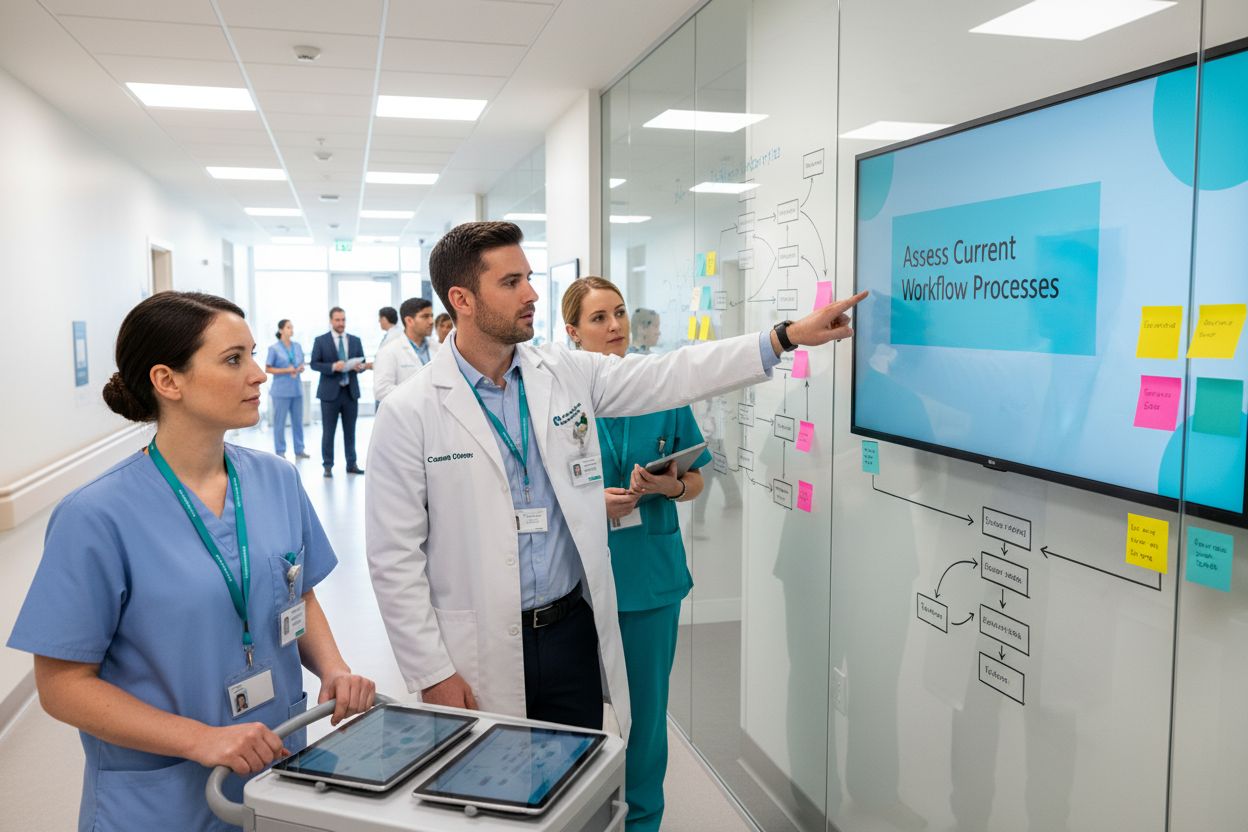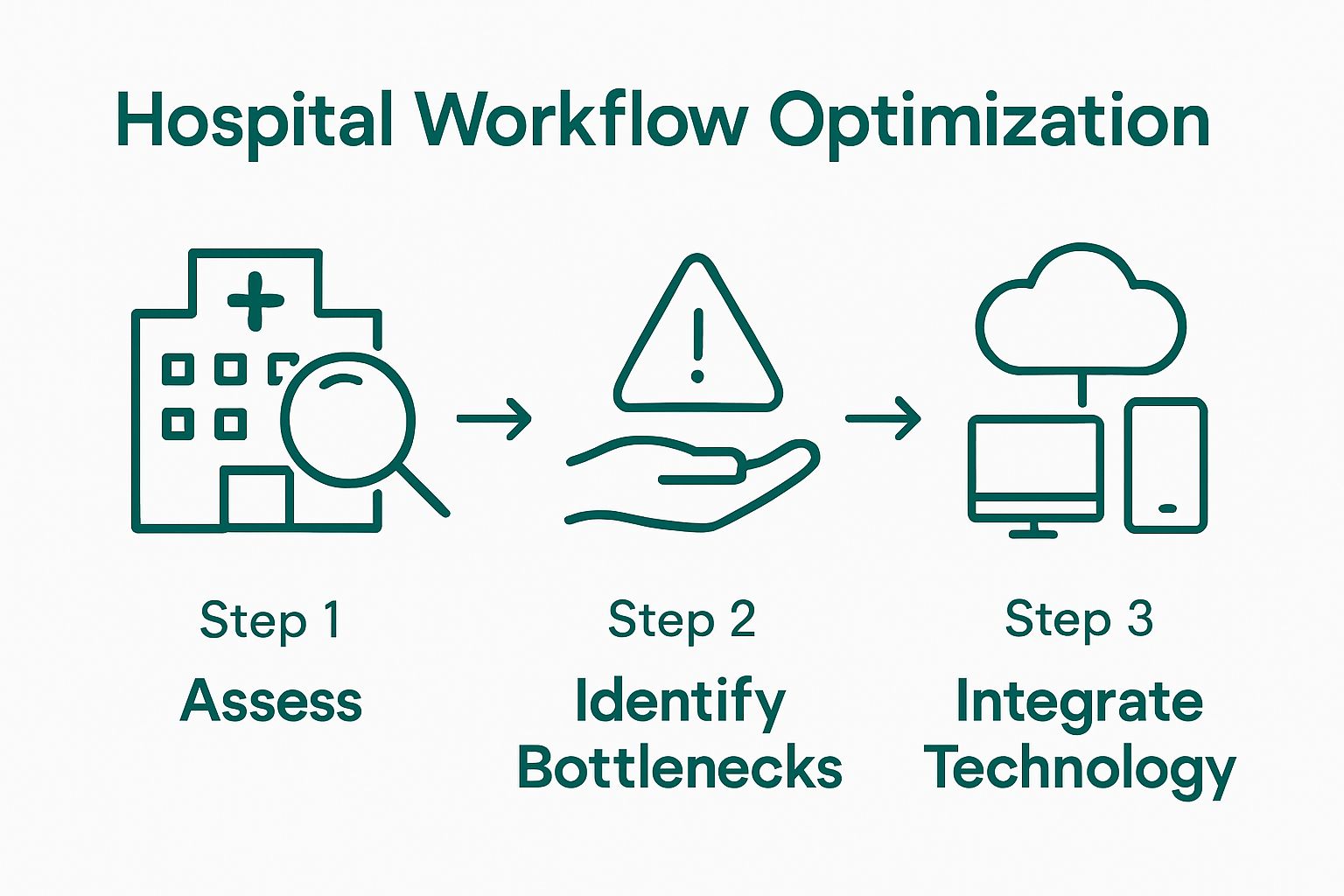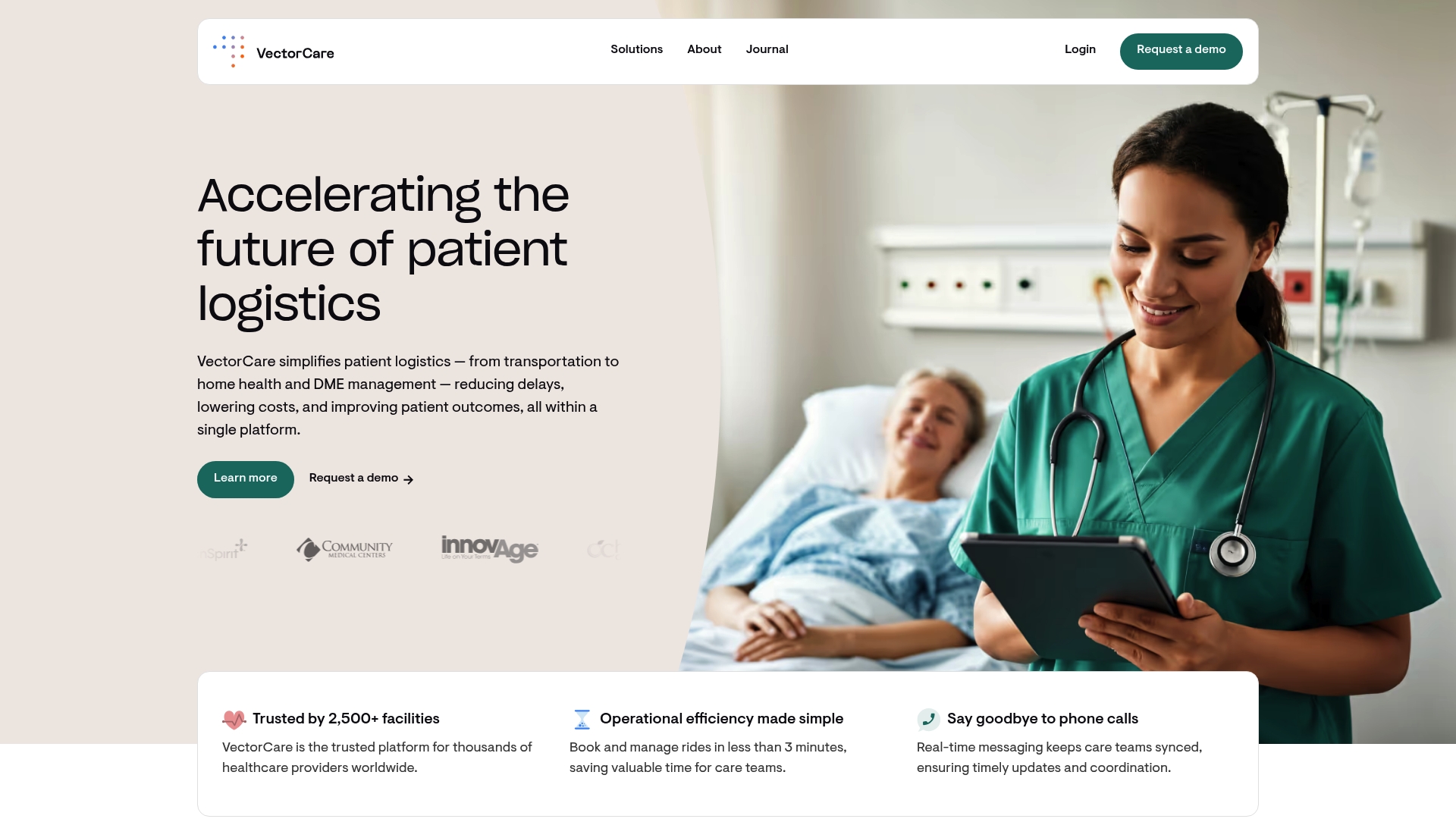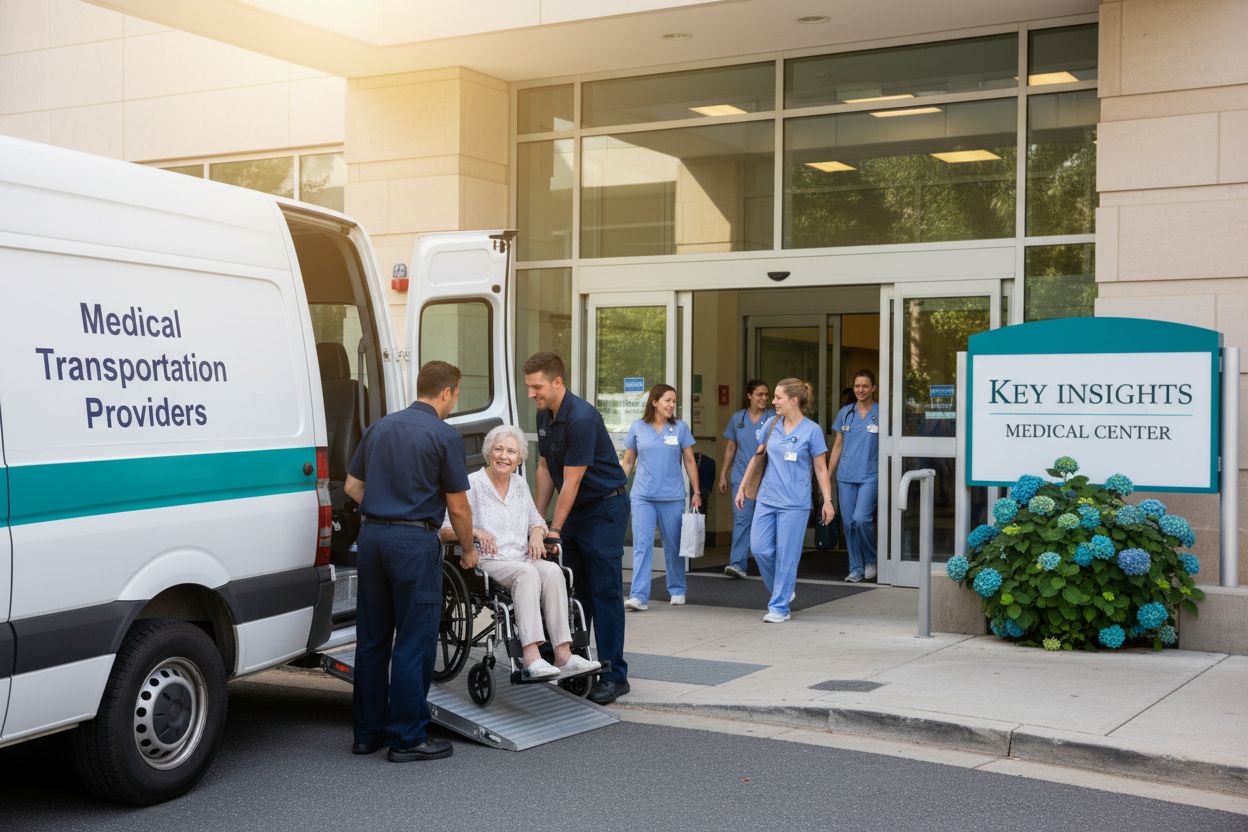Streamlining Hospital Workflows for Optimal Efficiency

Hospitals are always searching for ways to do more with less, especially when it comes to patient care and daily operations. Any given hospital worker spends up to 40 percent of their shift on administrative tasks instead of direct care. That sounds backwards, right? Most hospitals actually have the tools and the staff they need already—it all comes down to the flow of work. Fixing just a few hidden bottlenecks can unlock dramatic improvements nobody expects.
Table of Contents
- Step 1: Assess Current Workflow Processes
- Step 2: Identify Bottlenecks and Inefficiencies
- Step 3: Integrate Technology Solutions
- Step 4: Standardize Procedures and Protocols
- Step 5: Train Staff on New Workflows
- Step 6: Monitor Performance and Adjust as Needed
Quick Summary
| Key Point | Explanation |
|---|---|
| 1. Assess current workflows thoroughly | Perform detailed observations and staff engagements to identify inefficiencies in hospital processes. |
| 2. Engage staff for insights | Conduct interviews and focus groups with frontline workers to uncover daily operational challenges. |
| 3. Utilize technology effectively | Assess, select, and implement interoperable tech solutions to enhance workflow automation and communication. |
| 4. Standardize procedures for consistency | Create and document clear protocols to minimize variability and optimize patient care across departments. |
| 5. Monitor performance continuously | Establish data-driven performance reviews and feedback mechanisms for ongoing workflow optimization. |
Step 1: Assess Current Workflow Processes
Streamlining hospital workflows begins with a comprehensive and strategic assessment of existing processes. This critical first step provides healthcare administrators with an essential blueprint for identifying inefficiencies, bottlenecks, and opportunities for meaningful improvement. Understanding your current operational landscape allows targeted interventions that can dramatically enhance patient care and organizational performance.
To effectively assess current workflow processes, healthcare leaders must adopt a multifaceted approach that combines direct observation, staff engagement, and systematic documentation. Start by scheduling comprehensive walkthroughs of key hospital departments, carefully tracking how patient information, medical equipment, and staff interactions flow through different stages of care delivery. Pay close attention to transition points where handoffs occur between departments or personnel, as these areas frequently represent potential friction points in the workflow.
Engaging frontline staff becomes paramount during this assessment phase. Schedule structured interviews and focus groups with nurses, technicians, administrative personnel, and medical professionals across various departments. These conversations provide invaluable insights into daily operational challenges that might not be immediately apparent through passive observation. Ask specific questions about recurring obstacles, time-consuming manual processes, and potential technological or procedural improvements they envision.
Documentation becomes your most powerful tool in this assessment. Create detailed process maps that visually represent each step of patient care and administrative workflows. According to Agency for Healthcare Research and Quality, these visual representations help identify redundant steps, unnecessary delays, and opportunities for standardization. Utilize digital workflow mapping tools that allow real-time collaboration and easy modification as your understanding evolves.
Successful workflow assessment requires a comprehensive data collection approach. Collect and analyze key performance metrics such as:
- Average patient wait times
- Staff time allocation across different tasks
- Frequency of communication breakdowns
- Number of manual data entry steps
- Percentage of time spent on administrative versus direct patient care activities
By meticulously documenting and analyzing these metrics, healthcare administrators can transform subjective perceptions into objective, actionable insights that drive meaningful workflow optimization strategies.

Step 2: Identify Bottlenecks and Inefficiencies
Identifying bottlenecks and inefficiencies represents a critical transformation point in streamlining hospital workflows. This step moves beyond observation into strategic analysis, uncovering the hidden obstacles that impede smooth patient care and operational effectiveness. By systematically dissecting current processes, healthcare administrators can pinpoint precise areas requiring targeted interventions.
Time-motion studies emerge as a powerful diagnostic tool in this process. Healthcare leaders should conduct detailed tracking of staff movements, communication patterns, and task completion times across different departments. Pay special attention to transition points where patient handoffs occur, as these moments frequently represent significant workflow friction. Utilize digital stopwatch applications or specialized healthcare workflow tracking software to capture granular performance data with precision and objectivity.
Engaging multidisciplinary teams becomes crucial during bottleneck identification. Create cross-functional working groups that include representatives from nursing, administration, medical staff, and technical support. These collaborative sessions allow for comprehensive perspective sharing, revealing systemic challenges that might remain invisible when examined through a single departmental lens. Explore our guide on improving patient flow to gain deeper insights into potential optimization strategies.
Data analysis provides the foundation for meaningful workflow transformation. Collect and analyze key performance indicators such as patient wait times, staff productivity metrics, equipment utilization rates, and communication efficiency. Look for recurring patterns that suggest systemic inefficiencies. Common red flags include excessive manual documentation, redundant communication channels, inconsistent supply chain management, and prolonged patient transfer processes.
Verification of bottleneck identification requires a rigorous approach. Develop a comprehensive scorecard that quantifies current inefficiencies, allowing for objective measurement and future comparison.
Below is a checklist table summarizing key verification criteria for identifying hospital workflow bottlenecks and inefficiencies, making it easy to track and assess bottleneck identification progress.
| Verification Criterion | Description | Criteria Example |
|---|---|---|
| Communication Time Lost | Total time lost due to communication breakdowns | Minutes/hours per shift |
| Unnecessary Administrative Steps | Number of redundant steps in workflows | Count per process |
| Resource Availability Delays | Frequency of equipment or resource delays | Incidents per week |
| Non-Patient Care Activity Ratio | Percentage of time spent on non-patient care | Percentage of total shift time |
| Manual Documentation Steps | Number of manual data entry steps in a process | Count per workflow |
- Total time lost due to communication breakdowns
- Number of unnecessary administrative steps
- Frequency of equipment or resource availability delays
- Percentage of time spent on non-patient care activities
By meticulously documenting these metrics, healthcare administrators transform subjective observations into concrete, actionable intelligence that drives meaningful workflow optimization strategies.
Step 3: Integrate Technology Solutions
Integrating technology solutions represents a transformative approach to streamlining hospital workflows, enabling healthcare organizations to transcend traditional operational limitations. This critical step involves strategically implementing digital tools that automate processes, enhance communication, and provide real-time insights into complex healthcare delivery systems.
Begin by conducting a comprehensive technology assessment that evaluates current digital infrastructure and identifies potential integration opportunities. Modern healthcare technology solutions should focus on interoperability, ensuring seamless data exchange between different systems and departments. Electronic Health Record (EHR) platforms, cloud-based communication tools, and AI-powered workflow management systems emerge as key technological interventions that can dramatically improve operational efficiency.
Careful vendor selection becomes paramount during technology integration. Research potential technological solutions that offer robust integration capabilities, user-friendly interfaces, and comprehensive support structures. Prioritize platforms that demonstrate flexibility in adapting to unique organizational workflows and provide scalable solutions that can grow alongside your healthcare facility’s evolving needs. Discover our top integration strategies to understand how advanced technological solutions can transform healthcare logistics.
Implementation requires a phased approach that minimizes disruption to existing operations. Start with pilot programs in select departments, allowing staff to gradually acclimate to new technological tools.
The following table provides an at-a-glance summary of technology solutions discussed in the article, including their main purpose and key benefits for streamlining hospital workflows.
| Technology Solution | Main Purpose | Key Benefit |
|---|---|---|
| Electronic Health Record (EHR) Systems | Centralize patient data and documentation | Enhances accessibility and data accuracy |
| Cloud-Based Communication Tools | Facilitate real-time staff communication | Improves interdepartmental coordination |
| AI-Powered Workflow Management | Automate operational processes | Increases efficiency and reduces errors |
Verification of successful technology integration involves tracking specific performance metrics that demonstrate tangible improvements. Key verification criteria should include:
- Reduction in manual documentation time
- Improved interdepartmental communication speed
- Enhanced data accuracy and accessibility
- Decreased patient wait times
- Increased staff productivity
By methodically implementing and measuring technological solutions, healthcare administrators can create a dynamic, responsive workflow ecosystem that prioritizes both operational efficiency and exceptional patient care.
Step 4: Standardize Procedures and Protocols
Standardizing procedures and protocols represents a foundational strategy for creating consistent, predictable, and high-quality healthcare delivery. This critical step transforms disparate operational practices into a unified system of best practices, reducing variability and minimizing potential errors across hospital departments.
Begin by conducting comprehensive documentation of existing workflows across all hospital departments. Create detailed process maps that capture every step of patient care and administrative procedures. Engage multidisciplinary teams, including frontline staff, administrators, and clinical leaders, to develop comprehensive standard operating procedures (SOPs) that reflect real-world operational nuances. According to National Center for Biotechnology Information, standardized protocols significantly reduce operational variability and enhance overall system reliability.
Developing these standardized protocols requires a collaborative and systematic approach. Organize cross-functional working groups that can draft, review, and refine procedural documentation. Focus on creating clear, concise instructions that are easily understood and implemented by staff at all levels. Utilize visual aids, flowcharts, and decision trees to make complex procedures more accessible and digestible. Ensure that each protocol includes specific steps, expected outcomes, potential variations, and clear accountability measures.
Implementation of standardized protocols demands a strategic rollout plan. Begin with pilot programs in select departments, allowing for iterative refinement before organization-wide deployment. Develop comprehensive training programs that not only teach the new procedures but also explain the underlying rationale. Create digital and printed reference materials that staff can easily access during their daily workflows. Implement a continuous feedback mechanism that allows frontline workers to provide insights and suggestions for protocol improvement.
Verification of successful protocol standardization requires robust tracking and measurement. Key verification criteria should include:
- Consistency of procedure execution across departments
- Reduction in procedural variations
- Decreased incident rates related to procedural errors
- Staff comprehension and adherence to new protocols
- Measurable improvements in patient care outcomes
By meticulously developing, implementing, and continuously refining standardized procedures, healthcare organizations can create a more reliable, efficient, and patient-focused operational environment.
Step 5: Train Staff on New Workflows
Training staff on new workflows represents a critical bridge between strategic planning and successful operational transformation. This step ensures that carefully designed protocols and technological solutions translate into meaningful, practical improvements across the entire healthcare organization.
Effective training goes far beyond traditional classroom instruction. Develop a comprehensive, multilayered training approach that acknowledges the diverse learning styles and professional backgrounds of healthcare personnel. According to National Center for Biotechnology Information, training programs that incorporate real-world scenarios and hands-on simulation significantly enhance staff comprehension and adoption of new workflows. Learn more about emerging healthcare technology trends to contextualize your training approach.
Create a structured training curriculum that combines multiple learning modalities. Develop interactive digital modules that allow self-paced learning, complemented by hands-on workshops and live simulation scenarios. These sessions should provide staff with opportunities to practice new workflows in controlled environments, allowing them to build confidence and muscle memory before implementing changes in real-world clinical settings. Include scenario-based training that mirrors actual workplace challenges, enabling staff to develop problem-solving skills specific to the new workflow protocols.
Recognize that successful training requires ongoing support and continuous learning opportunities. Establish a mentorship program where experienced staff members can guide colleagues through workflow transitions. Create dedicated support channels, including helpdesks, online resources, and regular follow-up training sessions. Implement a feedback mechanism that allows staff to share challenges, suggestions, and insights, demonstrating organizational commitment to continuous improvement.
Verification of training effectiveness requires comprehensive assessment strategies. Key verification criteria should include:
Here is a checklist table summarizing key verification criteria for successful staff training on new hospital workflows, helping ensure effective knowledge transfer and adoption.
| Verification Criterion | Description | Assessment Method |
|---|---|---|
| Staff Comprehension Assessment | Measures staff understanding of new workflows | Standardized tests or quizzes |
| Practical Skill Demonstration | Confirms ability to perform new tasks | Hands-on simulation exercises |
| Error Rate Tracking | Monitors mistakes during early adoption | Incident or error reporting |
| Staff Confidence and Comfort | Evaluates confidence using new systems | Surveys or interviews |
| Qualitative Feedback | Gathers staff perceptions and suggestions | Feedback forms or focus groups |
- Staff comprehension levels through standardized assessments
- Practical skill demonstration in simulated environments
- Reduced error rates during initial workflow implementation
- Staff confidence and comfort with new technological tools
- Qualitative feedback from frontline workers
By designing a holistic, supportive training approach, healthcare organizations can transform potential resistance into enthusiastic adoption, ensuring that workflow improvements translate into tangible operational enhancements.
Step 6: Monitor Performance and Adjust as Needed
Monitoring performance and making continuous adjustments represents the final crucial stage in streamlining hospital workflows, transforming initial implementation into a dynamic, responsive operational system. This step ensures that workflow improvements remain adaptive, addressing emerging challenges and capitalizing on ongoing opportunities for optimization.
Establishing a robust performance monitoring framework requires comprehensive data collection and analysis. Implement advanced digital dashboards that provide real-time visibility into key performance indicators across different hospital departments. According to Agency for Healthcare Research and Quality, tracking quantitative metrics allows organizations to identify precise areas requiring further refinement. Develop a systematic approach that captures both objective performance data and qualitative feedback from staff and patients.
Create a structured review process that involves regular performance assessment intervals. Schedule monthly or quarterly comprehensive workflow reviews where cross-functional teams analyze collected data, discuss emerging challenges, and collaboratively develop targeted improvement strategies. Utilize statistical process control techniques to differentiate between normal operational variations and significant performance deviations that require immediate intervention. Develop clear escalation protocols that outline specific actions to be taken when performance metrics fall below predetermined thresholds.
Encourage a culture of continuous improvement by making performance data transparent and accessible to staff at all levels. Implement communication channels that allow frontline workers to provide insights, suggest modifications, and participate actively in workflow optimization efforts. Design recognition programs that reward teams and individuals who contribute meaningful improvements to operational processes. This approach transforms performance monitoring from a top-down evaluation into a collaborative, organization-wide initiative.
Verification of effective performance monitoring involves tracking comprehensive performance indicators:
- Consistency of workflow execution
- Reduction in process variation
- Staff engagement and feedback levels
- Patient satisfaction metrics
- Cost efficiency improvements
- Error rate reductions
By establishing a dynamic, responsive performance monitoring system, healthcare organizations can create a sustainable framework for ongoing workflow optimization, ensuring that operational improvements continue to evolve and deliver tangible benefits.

Unlock True Hospital Efficiency With Digital Workflow Coordination
Does your team struggle with bottlenecks, wasted time, or breakdowns in hospital workflows? Manual paperwork, inefficient communication, and fragmented transport logistics can hold back even the best-run hospitals. The article highlighted how staff often face frustrating delays and excessive administrative tasks that impact care coordination, patient satisfaction, and operational costs. Now, imagine a unified solution that tackles these pain points head-on.

VectorCare’s digital platform was built to eliminate logjams in hospital workflows. Our end-to-end patient logistics suite offers real-time scheduling optimization, secure communication, and automated dispatch—all in a single, user-friendly system. By streamlining patient transport, equipment delivery, and home health requests, VectorCare gives your staff more time to focus on care. Discover how our platform reduces delays, lowers costs, and improves outcomes by visiting VectorCare today. To see how your hospital could benefit from seamless integrations and real-time data insights, review our top integration strategies and stay ahead of the curve with emerging healthcare technology trends. Take the first step toward transforming your workflows now—your patients and staff deserve it.
Frequently Asked Questions
How can I assess my hospital’s current workflows effectively?
Begin by scheduling comprehensive walkthroughs of key departments and documenting each step of patient care and administrative processes. Engage frontline staff through interviews to gather insights and create detailed process maps to visualize inefficiencies within the next 30 days.
What are common bottlenecks in hospital workflows that I should look for?
Typical bottlenecks include communication breakdowns during patient handoffs and excessive manual documentation processes. Identify these by conducting time-motion studies that track staff movements and task completion times over a few weeks.
What technology solutions should I consider to streamline hospital workflows?
Focus on integrating interoperable Electronic Health Record (EHR) systems, cloud-based communication tools, and workflow management software. Start by evaluating your current digital infrastructure and select technologies that align with your hospital’s specific operational needs within the next quarter.
How can I ensure staff adherence to new standardized procedures?
Implement comprehensive training programs that combine hands-on workshops with digital learning modules tailored to different staff roles. Monitor adherence through regular assessments and feedback mechanisms, aiming for at least an 80% compliance rate within 3 months of rollout.
What key metrics should I monitor to evaluate workflow performance?
Track metrics such as patient wait times, staff productivity, and error rates to gauge operational efficiency. Schedule monthly reviews to analyze this data and adjust workflows as needed to maintain continuous improvement.
How can I create a culture of continuous improvement in workflow management?
Encourage open communication channels where staff can provide feedback and suggest improvements to current processes. Implement recognition programs for teams that contribute valuable insights, fostering a collaborative environment that prioritizes ongoing operational enhancements.



